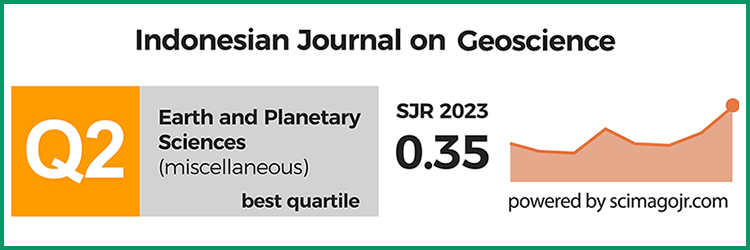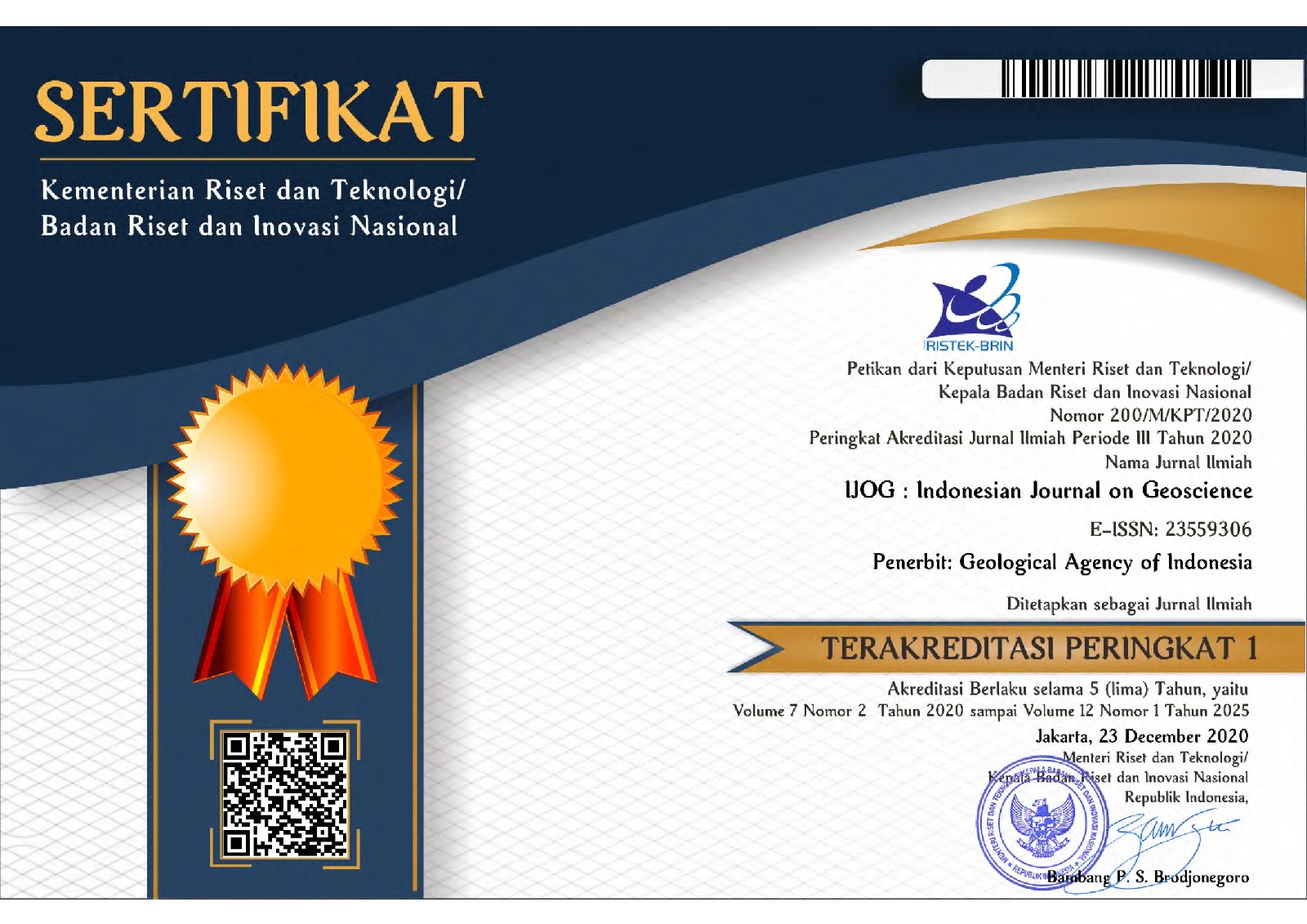Wrench-Slip Reversals and Structural Inversions: Cenozoic Slide-Rule Tectonics in Sundaland
DOI:
https://doi.org/10.17014/ijog.1.1.35-52Keywords:
transtensional vs. tranpressional wrenching, sequence, domains delineationAbstract
Most of continental Southeast Asia, that is, Sundaland and Indosinia, achieved a relative tectonic stability by the beginning of the Cenozoic. Since then a strong tectonic activity in Sundaland has been restricted to existing regional fault zones and to regional slow, vertical crustal movements elsewhere that produced small to very large sedimentary basins. On the other hand, regional deformation of Indosinia as a consequence of ductile shearing has continued into the Paleogene. Since the Oligocene, the northern part of Sundaland and Indosinia have been extruded differentially towards southeast along the Red River, Wang Chao (or Mae Ping, or Tonle Sap), and Three Pagodas - Axial Malay fault zones. The initial cause has been attributed to hard collision between Subplate India with Megaplate Eurasia. Plate dynamics in the region have changed substantially since Mid-Miocene as to force wrench-slip reversals along the major fault zones in Sundaland as well as in Indosinia. Concomitant structural inversions are demonstrated on seismic sections. In the core of Sundaland, earlier transtensional wrenching was succeeded by transpressive strike-slip faulting that on major faults of the Malay Basin manifested in reversals of sense. From the Hinge-line fault eastward, the transtensional left wrench slip was succeeded by transpressional dextral slip, while in the region to its west the wrench-slip kinematics was an earlier transtensional right slip followed by transpressional left slip. In the Strait of Malacca and eastern margin of Sumatra, right-lateral wrenching in the Neogene has been common. In certain places it could be established a wrench-slip of transtensional character in Oligocene-Early Miocene, and the transpressional wrench movement occurred mainly during the Middle to Late Miocene. The remarkable coincidence of termination of spreading of the South China Basin in Langhian, and that of the West Philippine and Caroline basins during Mid-Miocene invites further study.
References
Din, A.H., Omar, K.M., Naeije, M.C., and Ses, S., 2012. Long term sea level change in the Malaysian seas from multimission altimetry data. International Journal of Physical Sciences, 7 (10), p.1694-1712.
CCOP (U.N. Coordinating Committee for Offshore Prospecting), 1991. Total sedimentary isopach maps offshore East Asia (6 maps with explanatory text). CCOP, Bangkok, Thailand.
Daines, S.R., 1985. Structural history of the West Natuna Basin and the tectonic evolution of the Sunda region. Proceedings Indonesian Petroleum Association, 14th Annual Convention, Jakarta, 1, p.39-61.
Fenton, C.H., Charusiri, P., and Wood, S.H., 2003. Recent paleoseismic investigations in Northern and Western Thailand. Annals of Geophysics, 46(5), p.957-981.
Harun, Z., 1992. Anatomi sesar-sesar utama Semenanjung Malaysia. PhD Thesis, Universiti Kebangsaan Malaysia, 215pp. and maps.
Heidrick, T.L. and Aulia, K., 1993. A structural and tectonic model of the Central Plain Block, Central Sumatra basin, Indonesia. Proceedings Indonesian Petroleum Association, 22nd Annual Convention, Jakarta, p.285-317.
JMG (Jabatan Mineral dan Geosains Malaysia), 1985. Geological map of Peninsular Malaysia. Kuala Lumpur, Scale 1:500 000: 2 sheets.
Lacassin, R., Maluski, P., Leloup, P.H., Tapponnier, P., Hinthong, C., Siribakdi, K., Chuariraj, and Charoenrarat, A., 1997. Tertiary diachronic extrusion and deformation of western Indochina: structural and 40Ar/39Ar evidence from NW Thailand. Journal of Geophysical Research, 102 (B5), p.10013-10037. DOI:10.1029/96JB03831
Liew, K.K. 1995. Structural patterns within the Tertiary basement of Strait of Malacca, Geological Society of Malaysia Bulletin, 38, p.109-126.
Liew, K.K., 1996. Structural history of Hinge Fault system of the Malay Basin. Geological Society of Malaysia Bulletin, 39, p.33-50.
Madon, M. and Ahmad, M., 1996. Chapter 10. Basin in the Strait of Malacca. In: Leong, K.M. (ed.), “The petroleum geology and resources of Malaysia”. Petronas Kuala Lumpur, p.235-249.
Madon, M. and Anuar, A., 1999. Chapter 9. Penyu Basin. In: Leong, K.M. (ed.) “The petroleum geology and resources of Malaysia”. Petronas, Kuala Lumpur, p.219-233.
Ngah, K., Madon, M., and Tjia, H.D. 1996. Role of pre-Tertiary fractures in formation and development of the Malay and Penyu basins. In: Hall, R. and Blundell, D. (eds.), “Tectonic evolution of Southeast Asia”, The Geological Society, Special Publication, 106, p.281-290. doi:10.1144/GSL.SP.1996.106.01.18
Petronas, 1999. The petroleum Geology and resources of Malaysia. Research and Scientific Services and Petroleum Management Unit, 665 pp. DOI:10.1017/S0016756801225382
Raj, J.K., 1998. Tectonic evolution of the Tertiary basin at Batu Arang, Selangor Darul Ehsan, Peninsular Malaysia. Geological Society of Malaysia Bulletin, 42, p.197-210.
Rhodes, B.P., Charusiri, P., Kosuwan, S., and Lamjuan, A., 2005. Tertiary evolution of the Three Pagodas Fault, Western Thailand. In: Wannakao, L., Youngme, W., Srisuk, K., and Lertsirivorkul, R. (eds.), Proceedings of the International Conference on Geology, Geotechnology, and Mineral Resources of Indochina, Khon Kaen University, Thailand, p.498-505.
Roques, D., Matthews, S.J., and Rangin,, C., 1997. Constraints on strike-slip motion from seismic and gravity data along the Vietnam margin offshore Da Nang: implications for hydrocarbon prospectivity and opening of the East Vietnam Sea. In: Fraser, A.J., Matthews, S.J., and Murphy, R.W. (eds.), Petroleum Geology of Southeast Asia, Geological Society London, Special Publication, 126, p.341-353. doi: 10.1144/GSL.SP.1997.126.01.20
Sandal, S.T. (ed.), 1996. The Geology and Hydrocarbon Resources of Negara Brunei Darussalam, 1996 revision. Muzium Brunei Darussalam. DOI:10.1017/S0016756800031551
Shahar, S., 2008. Structural evolution of the Tenggol Arch and its implication for basement fracture patterns in the Malay Basin, Malaysia. Durham University, e-Masters Thesis, 324pp.
Tapponnier, P., Peltzer, G., le Dain, A.Y., Armijo, R., and Cobbold, P., 1982. Propagating extrusion tectonics in Asia: new insights from simple experiments with plasticene. Geology, 10, p.611-616. https://dx.doi.org/10.1130/0091-7613(1982)10<611:PETIAN>2.0.CO;2
Taylor, B. and Hayes, D.E., 1983. Origin and history of the South China Sea Basin. In: Hayes, D.E. (ed.), The tectonic and geologic evolution of Southeast Asian seas and islands, part 2. American Geophysical Union Monograph, 27, p.33-56. DOI:10.1029/GM027p0023
Tjia, H.D., 1977. Tectonic depressions along the transcurrent Sumatra fault zone. Geologi Indonesia, 4, p.13-27.
Tjia, H.D., 1998. Meridian-parallel faults and Tertiary basins of Sundaland. Geological Society of Malaysia Bulletin, 42, p.101-118.
Tjia, H.D. and Liew, K.K., 1996. Changes in tectonic stress field in northern Sunda Shelf basins. In: Hall, R. and Blundell, D. (eds.), Tectonic evolution of Southeast Asia, The Geological Society, Special Publication, 106, p.291-306. doi: 10.1144/GSL.SP.1996.106.01.19
Wongsosantiko, A. and Wirojudo, G.K., 1984. Tertiary tectonic evolution and related hydrocarbon potential in the Natuna area. Proceedings of Indonesian Petroleum Association, 13th Annual Convention, p.161-183. doi:10.1016/0360-5442(85)90059-3
Zuchiewicz, W. and Cuong, N.Q., 2009. Quaternary tectonics of the Red River Fault Zone in Vietnam - A morphotectonic approach. Geologia, Tom 35(2/1), p.367-374.



















